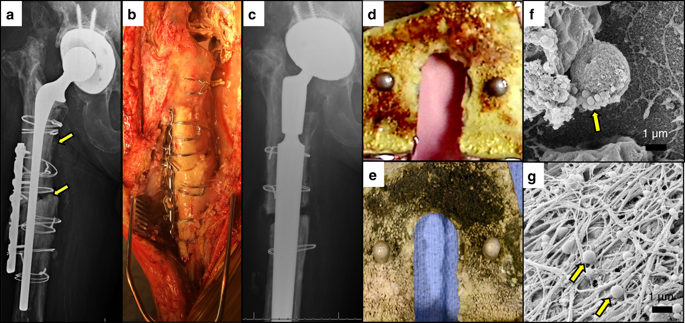Bone Research ( IF 12.7 ) Pub Date : 2019-07-15 , DOI: 10.1038/s41413-019-0061-z Elysia A Masters 1, 2 , Ryan P Trombetta 1, 2 , Karen L de Mesy Bentley 1, 3, 4 , Brendan F Boyce 1, 3 , Ann Lindley Gill 5 , Steven R Gill 5 , Kohei Nishitani 1, 6 , Masahiro Ishikawa 1, 6 , Yugo Morita 1, 6 , Hiromu Ito 6 , Sheila N Bello-Irizarry 1 , Mark Ninomiya 1 , James D Brodell 1 , Charles C Lee 1 , Stephanie P Hao 1 , Irvin Oh 1, 4 , Chao Xie 1, 4 , Hani A Awad 1, 2, 4 , John L Daiss 1, 4 , John R Owen 7 , Stephen L Kates 7 , Edward M Schwarz 1, 2, 3, 4, 5 , Gowrishankar Muthukrishnan 1, 4

|
Osteomyelitis is a devastating disease caused by microbial infection of bone. While the frequency of infection following elective orthopedic surgery is low, rates of reinfection are disturbingly high. Staphylococcus aureus is responsible for the majority of chronic osteomyelitis cases and is often considered to be incurable due to bacterial persistence deep within bone. Unfortunately, there is no consensus on clinical classifications of osteomyelitis and the ensuing treatment algorithm. Given the high patient morbidity, mortality, and economic burden caused by osteomyelitis, it is important to elucidate mechanisms of bone infection to inform novel strategies for prevention and curative treatment. Recent discoveries in this field have identified three distinct reservoirs of bacterial biofilm including: Staphylococcal abscess communities in the local soft tissue and bone marrow, glycocalyx formation on implant hardware and necrotic tissue, and colonization of the osteocyte-lacuno canalicular network (OLCN) of cortical bone. In contrast, S. aureus intracellular persistence in bone cells has not been substantiated in vivo, which challenges this mode of chronic osteomyelitis. There have also been major advances in our understanding of the immune proteome against S. aureus, from clinical studies of serum antibodies and media enriched for newly synthesized antibodies (MENSA), which may provide new opportunities for osteomyelitis diagnosis, prognosis, and vaccine development. Finally, novel therapies such as antimicrobial implant coatings and antibiotic impregnated 3D-printed scaffolds represent promising strategies for preventing and managing this devastating disease. Here, we review these recent advances and highlight translational opportunities towards a cure.
中文翻译:

骨感染中不断发展的概念:重新定义“生物膜”、“急性与慢性骨髓炎”、“免疫蛋白质组”和“局部抗生素治疗”。
骨髓炎是一种由骨微生物感染引起的破坏性疾病。虽然选择性骨科手术后的感染频率很低,但再感染率却高得令人不安。金黄色葡萄球菌是导致大多数慢性骨髓炎病例的原因,并且由于细菌在骨骼深处的持续存在,通常被认为是无法治愈的。不幸的是,对于骨髓炎的临床分类和随后的治疗算法没有达成共识。鉴于骨髓炎引起的高患者发病率、死亡率和经济负担,阐明骨感染的机制以指导预防和治疗的新策略非常重要。该领域的最新发现已经确定了三种不同的细菌生物膜储存库,包括:局部软组织和骨髓中的葡萄球菌脓肿群落,种植体硬件和坏死组织上的糖萼形成,以及皮质骨的骨细胞-腔隙小管网络(OLCN)的定植。相比之下,金黄色葡萄球菌在骨细胞中的细胞内持久性尚未在体内得到证实,这对这种慢性骨髓炎模式提出了挑战。我们对金黄色葡萄球菌免疫蛋白质组的理解也取得了重大进展,来自血清抗体和富含新合成抗体(MENSA)的培养基的临床研究,这可能为骨髓炎的诊断、预后和疫苗开发提供新的机会。最后,抗菌植入物涂层和抗生素浸渍的 3D 打印支架等新疗法代表了预防和管理这种毁灭性疾病的有希望的策略。在这里,我们回顾了这些最近的进展,并强调了治愈的转化机会。



























 京公网安备 11010802027423号
京公网安备 11010802027423号